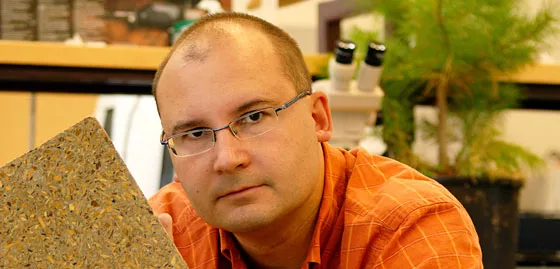Making Concrete With Wood

This photo shows the detail in the concrete-wood product. Download the high-resolution image.
"We’re seeing all kinds of additional applications, from countertops to flooring.”
British Columbia is facing a big question: what to do with the billions of trees killed by the mountain pine beetle? Sorin Pasca doesn’t have the whole answer but he has a concrete suggestion.
Beyond lumber and plywood, a research team comprised of Pasca and professors Ron Thring and Ian Hartley has discovered that mountain pine beetle (MPB) wood actually works as an excellent ingredient for producing concrete. Concrete is made by mixing cement with water and aggregate. Usually, the aggregate consists of stones or rocks, but MPB wood is a new option.
“Normally, cement repels organic materials, such as wood,” says Pasca, who recently completed his master’s degree at UNBC by researching this topic. “But for some reason, cement sticks to lodgepole pine and this compatibility is even stronger when the tree has been killed – or you could say, enhanced – by the mountain pine beetle.” Pasca’s research involved using three sizes of wood chips and three combinations of wood-to-cement ratios, for a total of nine different mixtures. These mixtures were created in a lab, poured into a mold, and left to cure. What emerged were boards that looked like a cross between plywood and concrete. You can drive a nail into them without pre-drilling. You can cut them with regular woodworking tools. They’re water-resistant. They’re stronger than many similar products currently on the market.

From beetle wood to finished product. Sorin Pasca with the different samples of concrete wood. Download the high-resolution image.
“The original idea was to see if a wood-cement product could be a replacement for drywall, or gypsum board,” says Pasca. “I think it’s an excellent alternative but now that the research is complete, we’re seeing all kinds of additional applications, from countertops to flooring. It’s a beautiful product that combines all of the structural advantages of concrete with the aesthetic quality of wood.”
The research is of tremendous value to the BC forest industry, which is seeking alternative wood products to complement the production of dimension lumber, plywood, wood pellets, and oriented strandboard. Research at UNBC – as well as the experience of sawmill operators – has shown that MPB wood exhibits considerable cracking shortly after mortality. As a result, many parts of the tree are no longer useful to mills that produce regular products.
“The whole issue of how we can maximize each tree is vital to the forest industry and the many communities of the province that depend on forestry for their survival,” says Ian Hartley, UNBC’s Associate Dean of Graduate Programs who participated in the research and is an expert in wood quality. “This research has produced a new product that deserves further investigation.”
National Forest Week September 23-29
UNBC is located at the epicentre of Canada's most productive forest region. The BC interior, for example, annually produces about as much lumber as Alberta, Ontario, and Quebec combined. In fact, the Northern BC forest industry produces enough lumber to build more than 640,000 homes. The mountain pine beetle is a major issue, devouring about 10 million hectares of pine forests and turning the wood a distinctive shade of blue. Responding to the pine beetle is a major issue for the forest industry and the communities that depend on it for their survival. Other UNBC research is exploring the shelf life of beetle wood, beetle genetics, their adaptability to spruce and other species of pine, the link to climate change, and the prospect of using pine trees to produce ethanol.
Video
Broadcast-quality video footage is available for the news media. Contact the Communications Office.
Contact